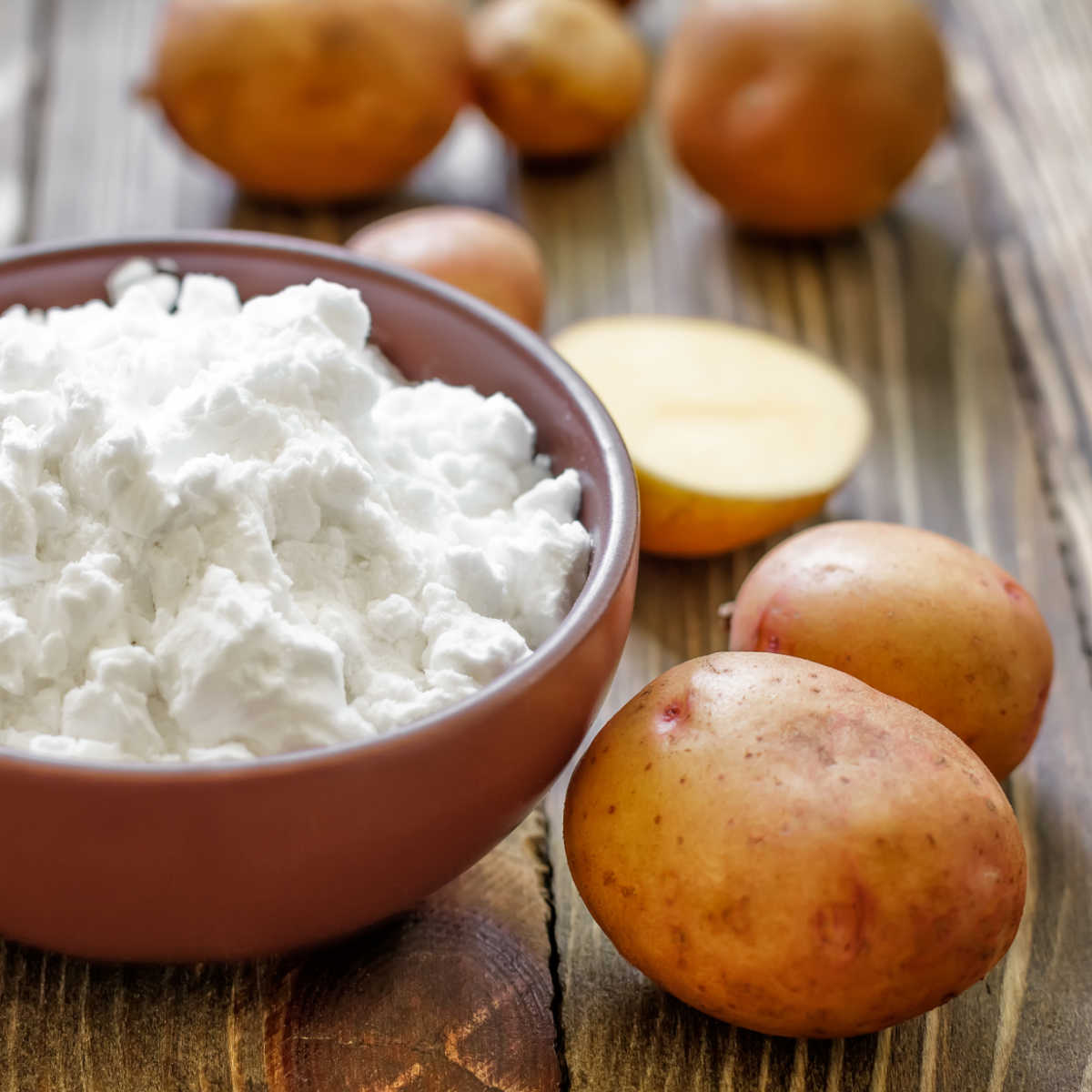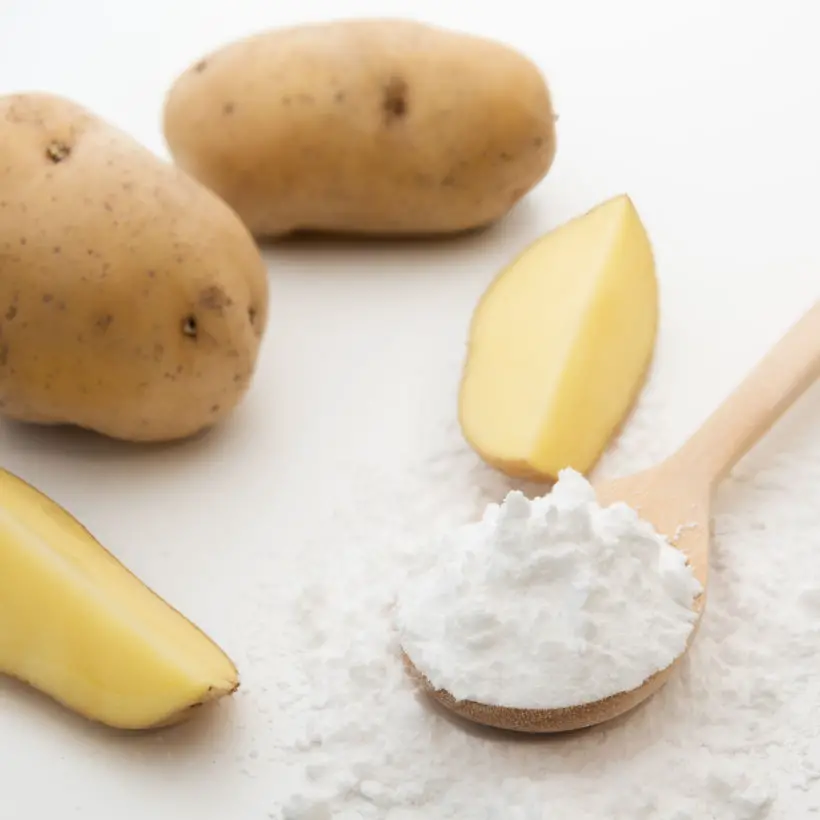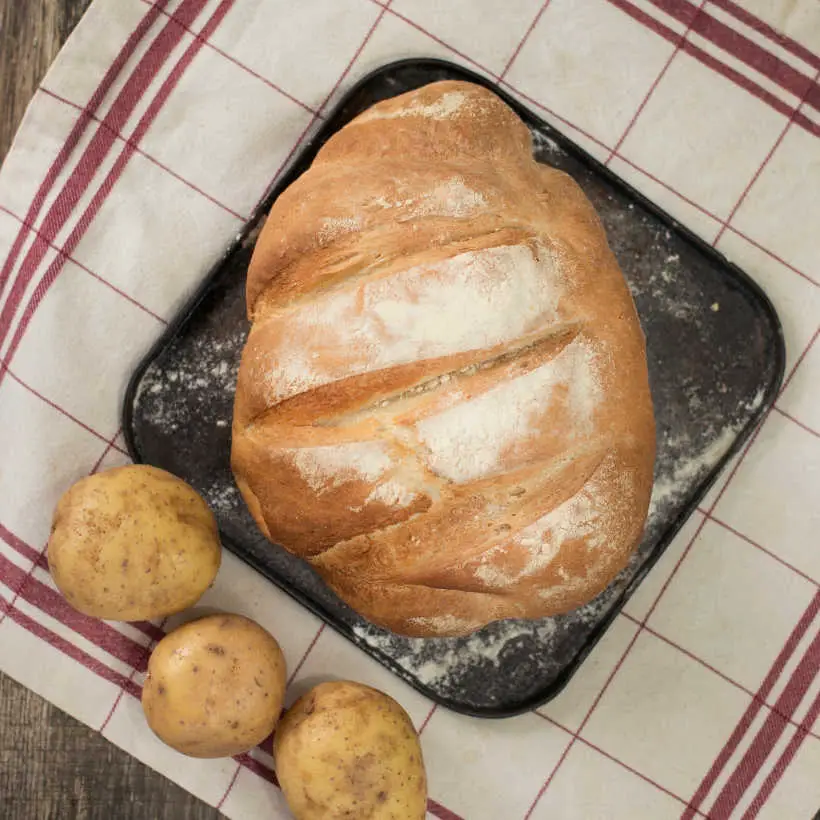Potato flour is made from potatoes and it’s naturally gluten free, suitable for vegan, vegetarian and Low FODMAP diet.
I like to try different types of flour when I’m baking my bread and cakes, so when I found potato flour at our recent farmers market visit, I couldn’t wait to get home and test a few recipes.
I’ve since experimented with making my own potato flour at home and it’s much easier than I thought and rather an enjoyable process.
I’m used to adding boiled potatoes to my bread or cakes, because it makes them softer, but I’ve not really used shop bought potato flour before (unless it was in a mix).

RECIPES WITH POTATOES
What is potato flour ?
Potato flour is essentially made from potatoes, which are dried and then milled (crushed) to a fine powder. Potato flour is usually very fine, light in texture and fairly white in colour.
Potato flour can be made from any kind of potatoes, but most flours are made from the white type of regular potatoes (e.g. not sweet potatoes or heritage coloured potatoes).
How is potato flour made
The process of turning potatoes into flour is quite simple and you can even try to make your own potato flour at home.
In commercial settings, the potatoes are first boiled, then crushed and dried until all the moisture evaporates. Finally, the dried potatoes are milled and packed into sealed bags for distribution.
What does potato flour taste like?
Not surprisingly, potato flour taste like potatoes, but it’s not unpleasant in any way. In most cases you would be adding your potato flour to a dish, flour mix or cake mix, where other flavours will overpower it anyway.
The shop bought potato flour has a very faint taste of potatoes, but if you make your own at home, the flavour will depend on the type of potato you use. I’ve sometimes used Gold Yukon Potatoes or suitable substitutes, because of their taste and light golden colour.
How to use potato flour
You can use potato flour in practically all baking and cooking, so here are just a few ideas, that I’ve tried over the years.
- Bread
- Brioche
- Soft Rolls
- Cakes
- Cupcakes
- Brownies
- Soups
- Stews, gumbo
Potato flour absorbs water a lot, so using 100% potato flour is usually not recommended unless the recipe doesn’t include a lot of flour in the first place (for example brownie recipes).
For cake baking you would normally mix potato flour with other types of flours, depending on whether you want to make gluten free bake or non-gluten free bake.
Potato flour can be mixed with any type of flour and it will typically make your final bake amazingly light and soft.
For example if baking a traditional white sandwich bread, swap no more than 50-100 grams (of 500 grams in total) of regular strong bread flour for potato flour to make your soft.

The difference between potato flour and potato starch
Although both the flour and starch are made from potatoes, they are very different in how they are made and what you’d use them for.
Potato starch is made from the protein particles of dried potatoes and it’s very fine in texture.
It’s used mainly for thickening soups, sauces, adding to flours, used in confectionery or making puddings. On it’s own it’s not a suitable replacement for potato flour.
Potato flour is made from the whole potoes – dried and milled and can be used for baking, cooking and general food preparation.
Potato flour substitute
If your recipe calls for potato flour and you haven’t got any, you can replace the flour with maze, rice or even regular plain (cake flour). It depends on whether you want to keep the flour replacement gluten free or you don’t mind using other types of flours.
If the recipe has just a small amount of potato flour (for example in soups, stews, gumbo or casseroles), it’s usually there to thicken the dish. In this case you can either use any kind of other flour you have (or even potato starch), add small boiled and mashed potato or leave it out completely.
What can be used instead of potato flour?
If you don’t have potato flour in your kitchen cupboard, but you need it for your recipe, here are few flour alternatives for you to try.
My favourite (and probably the best potato flour substitute) is rice flour, because it’s the same in terms of flavour, fine texture and colour. It’s also widely available in health shops but also in major supermarkets.
Potato starch/flour replacement
If your recipe uses the potato flour or starch to thicken the dish (e.g. soup, sauce, pudding, milk), then use corn starch, arrowroot powder, rice flour or even regular plain (all purpose flour).
There is usually only about 1-2 tablespoons as a quantity and pretty much any flour will do the job of thickening the recipe.
Replacement for potato flour in cake and bread baking
Depending on how much potato flour is in the recipe, you can get away with using other gluten-free flours such as rice or tapioca flour.
You can also boil your own potatoes, mash them dry and then add them to the recipe. If you are using this shift made potato flour, you’d need to adjust the amount of liquid in your recipe.
For example regular white bread would have 500 grams of white bread flour and about 320 ml of water.
I’d adjust the recipe by adding say 100 grams in boiled and mashed potatoes, using only the 400 grams of white bread flour and adding only 280 ml water.
Once you mix everything together, you’d know if you need to add more water or not. If the dough feels a little too tight, add more water.
You can also use leftover mashed potatoes instead of just keeping them in the fridge and using them later.
Is potato flour the same as corn flour?
No, not quite! Potato flour (if made directly from the whole potatoes) is not the same as corn flour.
But potato starch, which is made only from the protein starch derived from potatoes is interchangeable with corn flour or corn starch.
You can use it instead of corn flour and it will thicken your recipe in exactly the same way.

What does potato flour do in baking?
I’ve always loved using potato flour or even just mashed potatoes in my baking, because it softens the crust and makes your bread or cake much softer and lighter in texture.
The trick is to swap only about 10-20% of the overall amount of flour otherwise you might end up with a gooey mess.
The potato flour will give you a similar effect of soft bread to using a scalded flour method for bread baking. Combining these two things – potato flour & scalded flour – will result in even softer and lighter bread.
How much potato flour to use in bread
I’d recommend to use smaller amounts of potato flour for your bread baking to make your bread light and fluffy. For a regular bread (500 grams or 3 cups flour bread recipe) I would swap between 50 – 100 grams (1/4 – 1/2 cup) of regular flour for potato flour.
This will be enough to give your bread a lovely light texture and there will be still enough gluten from the rest of the regular bread flour to make sure that the bread rises and doesn’t collapse on it’self.
Where can I buy potato flour?
You can usually buy potato flour in your local health shop or specialist online shops.
How do I store my potato flour?
In the same way as any other flour – in air tight container and somewhere out of a direct sunlight. Cooler environment is probably better as you don’t want the flour to dry out too much.
MORE POTATO RECIPES
Is potato flour gluten free?
Yes, potato flour is gluten free, providing that the manufacturers didn’t add any other ingredient that includes gluten. It’s best to double check the potato flour mix to make sure that yours doesn’t contain any ingredient that could have gluten.
Potato flour is often used for gluten free flour mixes, so you’ll often see it as one of the flour type on the gluten free flour packaging.
How to use potato starch (or potato flour) to thicken soup
Simply add one tablespoon to a large soup when you want to thicken it – towards the end of making your soup.
Sometimes the potato starch or potato flour doesn’t disperse as easily as I’d like it, so I often dissolve it in a bit of a hot soup water first before adding the thick liquid back to the main soup saucepan.
If you know you want to add some potato flour or potato starch to your soup at the beginning, it’s worth melting some butter first and adding the starch or potato flour to the butter and very slowly brown the whole mixture.
When the butter and the flour/starch forms a thicken batter, add the rest of your soup ingredients and carry on with your soup recipe.
You can also make the buttery flour batter in a separate saucepan and add it to your soup any time when you want to thicken it.
This blog post was originally written on 26 April 2021 and last updated 22 June 2022








Leave a Reply